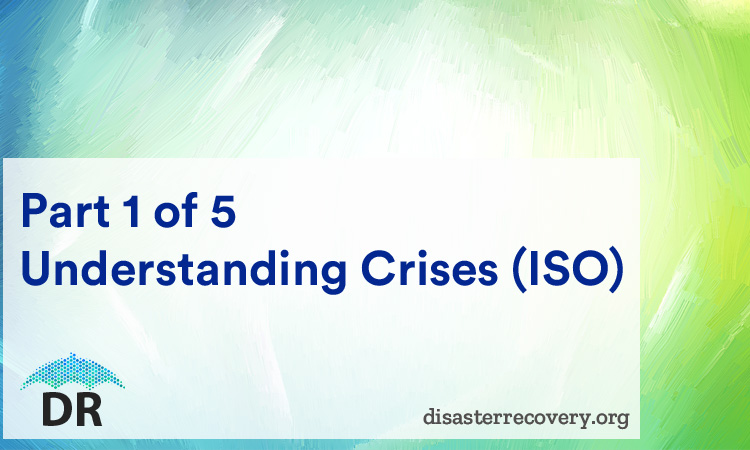Risks that can be identified and assessed besides having an easily discernible pattern are contributing factors that lead to incidents . This is the main reason why incidents are said to be structural in nature.
Part 1 of 5 Understanding Crises (ISO)

Within the ambit of business continuity management (BCM), pre-prepared strategies are the most common responses to such incidents. In such cases, strategic management is concerned more often than not with keeping the BCM plan up and running with adequate manpower in order to back the company’s objectives.
Crises , however, are a product of an unanticipated combination of interrelated and unidentified risks. They evolve without any set pattern which is why responding to them requires spontaneous efforts as opposed to prior planning in the case of an incident.
Pre-defined strategies can be counterproductive while dealing with a crisis. Managing a crisis is beyond the scope of conventional, structured and pre-planned BCM procedures. In such a scenario, strategic management becomes all the more important. Needless to say, responding involves proactive decision making and sound leadership without the assistance of a blue print for action. This is why crisis management falls strictly under the purview of a company’s top management .
- Establish differences between BCM and crisis management
- Differences between BCM and crisis management should reflect in their corresponding response strategies
¹situation that might be, or could lead to, a business disruption, loss, emergency or crisis
²holistic management process that identifies potential threats to an organization and the impacts those threats, when realized, might cause, and which provides a framework for building organizational resilience with the capability for safeguarding the interests of its key stakeholders, reputation, brand and value-creating activities [BS 25999-1:2006, Business continuity management – Code of practice, and BS 25999-2:2007, Business continuity management – Specification]
³inherently abnormal, unstable and complex situation that represents a threat to the strategic objectives, reputation or existence of an organization
- Organization governance and strategy review should include the creation and maintenance of crisis management capabilities
- Capabilities to simultaneously execute crisis management and BCM responses, if required, should be developed
⁴person or group of people directing and controlling an organization at the highest level
A companywide crisis is only the visible symptom of a combination of underlying organizational, operational and managerial faults. Blaming individuals, systems, processes or business models will only allow the underlying problems to persist, leaving the organization vulnerable. Crises provide great opportunities for learning and improvement if focusing on technical glitches and individual failures is avoided.
Characteristics of a Crisis
- Highly complex problems with unclear implications
- Responses often involve choosing the least bad solution
- Threatens organization norms, image, values, reputation and brand
- Puts management under immense pressure
- Can become politicized and put companies under public and media scrutiny
- Correct handling can bring new opportunities and benefits
- Involves false perceptions, rumors and misreporting
- Recovery can create new opportunities and/or close business processes
- Tests the abilities of staff, management and leadership
Recommendations
- Selection, training and development of staff is of prime importance
- Seniority and experience of individuals should not be given preference while determining their crisis management abilities
- Crisis management tasks should be included in individuals’ job profile, yearly assessment and training
Types of Crises
Sudden Crises
- Unanticipated
- Escalate very quickly
- Caused by factors beyond organization’s control
Smoldering Crises
- Grow over a period of time
- Crises indicators are often overlooked
Factors Contributing to a Crisis
- Business, political, economic and social environment related changes
- Poor management and ineffective communication
- Non adherence to quality and/or safety standards
- Breaches of standards of probity, ethics and corporate responsibility
- Steady accumulation of faults and bad practice
- Supply chain and logistics related inefficiencies
Crises are often caused by latent errors that lie dormant for an extended period of time during which they gather momentum until a triggering event exposes them and disrupts business. Some of the contributing causes include:
- Consistent compromise of quality and safety standards
- Overcomplicated processes
- Unrealistic schedules
- Manpower shortages
- Lack of trained professionals
- Poor supervision
Resilience to Crisis
An organization that is effective at avoiding or mitigating crises has a high level of reliability. This allows them to operate under highly volatile circumstances with a very low incidence of accidents or failure. Key features include:
- Rigorous examination of previous disruptions
- System, business and environmental complexities are factored into all strategic, planning and operational decisions.
- Sound understanding of the real world constraints of frontline operations
- A free and proactive sharing of information in order to develop a collective and collaborative response
- Comprehensive and elaborate training procedures
- Seamless transition between normal and crisis mode of operations achieved through an emphasis on expertise rather than corporate hierarchy
However, many obstacles exist in the current business scenario that might impede achieving an organization wide resilience to crises.
- Inflexible core beliefs, values and assumptions
- Underestimating the impact of a crisis
- Persistence of underlying factors that led to previous crises
- An organizational culture that is not conducive to fostering resilience
- Focusing on who or what to blame rather than fixing the problem
- Inadequate training, personnel and support
- Insensitivity to the human aspect/dimension of a crisis
Resilience to Crisis
A large part of dealing with a crisis involves understanding the factors that contribute to them even before the crisis actually occurs. Creating, testing and executing a crisis management system give the organization a great opportunity to collaborate and collectively arrive at a sturdy and robust business model that is flexible and easily adaptable to change. An effective crisis management system boosts the overall perception that customers, stakeholders and markets have of an organization. Equipping employees with the tools and skills necessary to handle a crisis indirectly improves their productivity thanks to a greater sense of awareness, responsibility and involvement.

